List of National Treasures of Japan (castles)
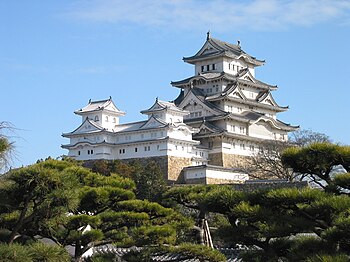
The Japanese
A new era of castle construction began when the daimyo Nobunaga built
Almost 100 major castles were built between 1596 and 1615.
The term "
Features

The fifteen national
treasures are distributed over six castles as follows: Nijo Castle has six national treasure structures, Himeji Castle has five national treasure structures; Hikone Castle, Inuyama Castle, Matsue Castle and Matsumoto Castle each have one. Three main types of
castles exist. Generally the types are characterised according to the
topography of the castle's site and named accordingly:
mountain castles (山城, yamajiro); flatland
castles (平城, hirajiro), as exemplified by Matsumoto Castle; and
flatland mountain castles (平山城, hirayamajiro), which are
castles built on hills in a plain such as Himeji Castle, Hikone Castle, Inuyama Castle, and Matsue Castle.[14]
The
Only in rare cases the donjon stands independent of other structures. Generally it is connected to smaller watch towers called yagura, either directly (fukugōshiki (複合式)) or via a connecting gallery (渡櫓, watariyagura) in which case the style is called renketsushiki (連結式).[18][19] Matsumoto Castle has both styles, renketsushiki in the northwest and fukugōshiki in the southeast. At Himeji Castle three watch towers, four connecting galleries and the main donjon enclose a small courtyard.[17] A typical keep would have between three and seven stories discernible from the outside. Its inner structure including the number of floors could differ from the outward appearance.[20] Castle towers at Himeji, Inuyama, Matsue and Matsumoto Castle have one floor more than is visible from the outside.
Usage
The table's columns (except for Image) are sortable pressing the arrows symbols. The following gives an overview of what is included in the table and how the sorting works.
- Name: name of the structure as registered in the Database of National Cultural Properties[12][nb 1][nb 2]
- Castle: name of the castle in which the structure is located
- Construction: architecture and general remarks including the number of stories (outside) and floors (inside); the column entries sort by the type of structure (donjon, yagura, watariyagura)
- Date: period and year of the construction; the column entries sort by year. If only a period is known, they sort by the start year of that period.
- Location: "town-name prefecture-name" and geo-coordinates of the structure; The column entries sort as "prefecture-name town-name".
- Image: picture of the structure; If the image shows more than one structure, the respective structure is indicated by a blue rectangle.
Treasures
| Name | Castle | Construction | Date | Location | Image |
|---|---|---|---|---|---|
| Tenshu (天守)[nb 1][21] | Hikone Castle | donjon, three stories/three floors with an underground room and entry hall, hongawarabuki roof[ex 1]
|
Momoyama period , 1606
|
Hikone, Shiga 35°16′35.21″N 136°15′6.64″E / 35.2764472°N 136.2518444°E |

|
| Connecting tower (附櫓, tsukeyagura) and Tamon Tower (多聞櫓, tamon yagura)[nb 1][21] | Hikone Castle | yaguras, each single-storied, hongawarabuki roof[ex 1] | Momoyama period , 1606
|
Hikone, Shiga 35°16′35.74″N 136°15′6.68″E / 35.2765944°N 136.2518556°E |

|
| Big Tenshu (大天守, daitenshu)[23] | Himeji Castle | main | Momoyama period , 1608
|

| |
| Northwest Small Tower (乾小天守, inui kotenshu)[24] | Himeji Castle | Momoyama period , around 1609
|
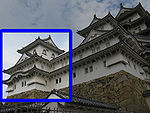
| ||
| West Small Tower (西小天守, nishi kotenshu)[25] | Himeji Castle | Momoyama period , around 1609
|

| ||
| East Small Tower (東小天守, higashi kotenshu)[26] | Himeji Castle | Momoyama period , around 1609
|
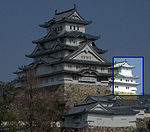
| ||
| I, Ro, Ha, Ni-corridors (イ, ロ, ハ, ニの渡櫓, i, ro, ha, ni no watariyagura)[nb 3][nb 4][27] | Himeji Castle | two stories/two floors with a one-story basement, hongawarabuki roof;[ex 1] I-corridor: between Big Tenshu and East Small Tower, 9.03 metres (29.6 ft) high on a 8.88 m (29.1 ft) high stone wall |
Momoyama period , around 1609
|

| |
| Tenshu (天守)[28] | Inuyama Castle | donjon, three stories/four floors with a two-story basement, ca 25 m (82 ft) high, with hongawarabuki roof.[ex 1] There are single-storied watchtowers with hongawarabuki roofs on the south and west side
|
Momoyama period , 1601
|
Inuyama, Aichi 35°23′18″N 136°56′21″E / 35.38833°N 136.93917°E |

|
| Tenshu (天守)[nb 5][29][30] | Matsue Castle | donjon, four stories/five floors with an underground room, hongawarabuki roof[ex 1]
|
Momoyama period , 1607–1611
|

| |
| Connecting tower (附櫓, tsukeyagura)[nb 5][29][30] | Matsue Castle | yagura, one story/one floor, hongawarabuki roof[ex 1] | Momoyama period , 1607–1611
|

| |
| Tenshu (天守)[nb 2] | Matsumoto Castle | main donjon, five stories/six floors, with hongawarabuki roof[ex 1]
|
Momoyama period, Bunroku era
|
Matsumoto, Nagano 36°14′19.03″N 137°58′7.87″E / 36.2386194°N 137.9688528°E |
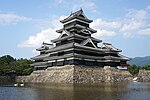
|
| Northwest Small Tower (乾小天守, inui Kotenshu)[nb 2] | Matsumoto Castle | secondary donjon, three stories/four floors, hongawarabuki roof[ex 1]
|
Momoyama period, Bunroku era
|
Matsumoto, Nagano 36°14′19.66″N 137°58′7.81″E / 36.2387944°N 137.9688361°E |

|
| Connecting Tower (渡櫓, watari yagura)[nb 2] | Matsumoto Castle | yagura, two stories/two floors, hongawarabuki roof[ex 1] | Momoyama period, Bunroku era
|
Matsumoto, Nagano 36°14′19.42″N 137°58′7.8″E / 36.2387278°N 137.968833°E |
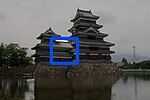
|
| Southeast Connecting Tower (辰巳附櫓, tatsumi tsukeyagura)[nb 2] | Matsumoto Castle | yagura, two stories/two floors, hongawarabuki roof[ex 1] | Momoyama period, Bunroku era
|
Matsumoto, Nagano 36°14′18.76″N 137°58′8.32″E / 36.2385444°N 137.9689778°E |

|
| Moon-viewing Tower (月見櫓, tsukimi yagura)[nb 2] | Matsumoto Castle | yagura, one-storied with one-storied basement, hongawarabuki roof[ex 1] | early Edo period, Kan'ei era | Matsumoto, Nagano 36°14′18.77″N 137°58′8.63″E / 36.2385472°N 137.9690639°E |

|
| Nijo Castle Ninomaru Palace and Waiting Room and Carriage Porch (二条城 二の丸御殿遠侍及び車寄, nijōjō ninomaru goten tōzamurai oyobi kurumayose) | Nijo Castle
|
goten waiting room building, one storied with tile roof and 'kurumayose' entrance with cypress bark roof | early Edo period, 1625-1626 | Kyoto, Kyoto
| |
| Nijo Castle Ninomaru Palace Reception Room (二条城 二の丸御殿式台, nijoujou ninomaru goten shikidai) | Nijo Castle
|
goten reception hall structure, one-storied with tiled roof | early Edo period, 1625-1626 | Kyoto, Kyoto
| |
| Nijo Castle Ninomaru Palace Great Hall (二条城 二の丸御殿大広間, nijoujou ninomaru goten oohiroma) | Nijo Castle
|
goten main hall structure, one-storied gable style with tiled roof | early Edo period, 1625-1626 | Kyoto, Kyoto
| |
| Nijo Castle Ninomaru Palace Sotetsu Room (二条城 二の丸御殿蘇鉄之間, nijōjō ninomaru goten sotetsu no ma) | Nijo Castle
|
goten passageway structure, one-storied with tiled roof | early Edo period, 1625-1626 | Kyoto, Kyoto
| |
| Nijo Castle Ninomaru Palace Black Drawing Room (Small Great Hall) (二条城 二の丸御殿黒書院(小広間), nijōjō ninomaru goten kuroshoin (ko hiroma)) | Nijo Castle
|
goten hall structure, one-storied gable style with tiled roof | early Edo period, 1625-1626 | Kyoto, Kyoto
| |
| Nijo Castle Ninomaru Palace White Drawing Room (Throne Room) (二条城 二の丸御殿白書院(御座の間, nijōjō ninomaru goten shiroshoin (gozanoma)) | Nijo Castle
|
goten hall structure/throne room, one-storied gable style with tiled roof | early Edo period, 1625-1626 | Kyoto, Kyoto
|
 |
See also
Notes
- General
- ^ a b c d The National Treasure structures of Hikone Castle are registered as a single National Treasure under one registration number. Only in the main treasure table of this article, the single entry is split in two parts for readability.
- ^ a b c d e f g The National Treasure structures of Matsumoto Castle are registered as a single National Treasure under one registration number. Only in the main treasure table of this article, the single entry is split in five parts for readability.
- ^ a b c d e The four corridors at Himeji Castle are labeled as "I", "Ro", "Ha", "Ni" corresponding to "A", "B", "C", "D".
- ^ The kitchen is attached to the nomination.
- ^ a b The National Treasure structures of Matsue Castle are registered as a single National Treasure under one registration number. Only in the main treasure table of this article, the single entry is split in two parts for readability.
- Architecture
References
- ^ Turnbull & Dennis 2003, p. 52
- ^ a b c d e Deal 2007, p. 315
- ^ Coaldrake 1996, p. 104
- ^ a b Nishi & Hozumi 1996, p. 93
- ^ a b Coaldrake 1996, p. 106
- ^ Coaldrake 1996, pp. 105–106
- ^ Turnbull & Dennis 2003, p. 21
- ^ Deal 2007, p. 318
- ^ a b Coaldrake 1996, p. 105
- ^ Coaldrake 1996, p. 248
- ^ "Cultural Properties for Future Generations" (PDF). Tokyo, Japan: Agency for Cultural Affairs, Cultural Properties Department. March 2017. Archived from the original (PDF) on 2017-12-16. Retrieved 2017-12-17.
- ^ a b c 国指定文化財 データベース [Database of National Cultural Properties] (in Japanese). Agency for Cultural Affairs. Archived from the original on 2017-05-02. Retrieved 2017-12-17.
- ^ https://nijo-jocastle.city.kyoto.lg.jp/introduction/highlights/ninomaru/?lang=en
- ^ Deal 2007, p. 316
- JAANUS – Japanese Architecture and Art Net User System. Retrieved 2009-11-09.
- JAANUS – Japanese Architecture and Art Net User System. Retrieved 2009-11-09.
- ^ a b "Donjon". jcastle.info. Archived from the original on 2017-12-16. Retrieved 2017-12-17.
- JAANUS – Japanese Architecture and Art Net User System. Retrieved 2009-11-09.
- JAANUS – Japanese Architecture and Art Net User System. Retrieved 2009-11-09.
- ^ Turnbull & Dennis 2003, p. 30
- ^ a b "Hikone Castle". jcastle.info. Archived from the original on 2017-12-16. Retrieved 2017-12-17.
- JAANUS – Japanese Architecture and Art Net User System. Retrieved 2009-11-09.
- Himeji city. Archived from the originalon 2016-06-24. Retrieved 2009-11-17.
- Himeji city. Retrieved 2009-11-17.
- Himeji city. Archived from the originalon 2016-06-24. Retrieved 2009-11-17.
- Himeji city. Archived from the originalon 2016-06-24. Retrieved 2009-11-17.
- Himeji city. Archived from the originalon 2016-05-08. Retrieved 2009-11-17.
- ^ "Inuyama Castle". Japanese National Tourism Organization. Retrieved 2011-08-29.
- ^ a b "Matsue Castle". jcastle.info. Archived from the original on 2017-12-16. Retrieved 2017-12-17.
- ^ Matsue city. Retrieved 2015-09-21.
Bibliography
- Cluzel, Jean-Sébastien (2008). Architecture éternelle du Japon – De l'histoire aux mythes (illustrated ed.). Editions Faton. ISBN 978-2-87844-107-9. Retrieved 2011-07-20.
- Coaldrake, William Howard (1996). Architecture and authority in Japan. Nissan Institute/Routledge Japanese studies (illustrated ed.). ISBN 978-0-415-05754-7. Retrieved 2009-11-22.
- Deal, William E. (2007) [1973]. Handbook to life in medieval and early modern Japan (illustrated, revised ed.). New York: ISBN 978-0-19-533126-4. Retrieved 2009-11-10.
- Nishi, Kazuo; Hozumi, Kazuo (1996) [1983]. What is Japanese architecture? (illustrated ed.). Kodansha International. ISBN 978-4-7700-1992-9. Retrieved 2009-11-11.
- Turnbull, Stephen; Dennis, Peter (2003). Japanese castles 1540–1640. Fortress Series. Vol. 5. Osprey Publishing. ISBN 978-1-84176-429-0. Retrieved 2009-11-11.


